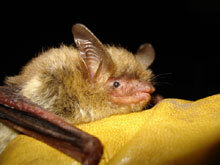White-Nose Syndrome Hitting Wisconsin Bat Population Hard
Friday, December 30th, 2022 -- 9:01 AM

(By Danielle Kaeding, Wisconsin Public Radio) A little over a decade ago when a monitoring team from the Wisconsin Department of Natural Resources went searching for hibernation spots, staff members found hundreds of northern long-eared bats sleeping away their winters at more than 60 sites around the state.
According to Danielle Kaeding with Wisconsin Public Radio, then white-nose syndrome made its way to Wisconsin, and what researchers found quickly began to change. "Just this last winter, the current hibernation season, they saw three northern long-eared bats at only two sites.
So, they are almost gone, unfortunately, from the state of Wisconsin," said Owen Boyle, the DNR’s species management section manager. White-nose syndrome was first discovered in New York in 2006. The fungal disease looks like white fuzz on bats' skin.
And while the disease itself doesn't kill them, it wakes the bats up while they’re hibernating in caves or abandoned mines and has them burning through fat stores until they eventually starve. It was found in Wisconsin in 2014.
Since its discovery in North America, fungal disease has decimated the northern long-eared bat with population declines of 97 percent or more documented across two Canadian provinces and 27 states, including Wisconsin.
That led the Biden administration to list the bats as an endangered species in November in the hope of preventing them from disappearing altogether. The listing seeks to provide greater protection to surviving bats in wooded areas where bats roost during the summer and sites where they hibernate.
Wisconsin listed the northern long-eared bat as a state threatened species in 2011, and the U.S. Fish and Wildlife Service listed the species as threatened in 2015. The bats are smaller than the length of a hand, ranging about 3 to 4 inches.
They emerge at night to feed on insects like moths and flies, providing natural pest control with widespread benefits. One study estimated the loss of bats due to white-nose syndrome and wind developments could cost agriculture more than $3.7 billion each year.
Feel free to contact us with questions and/or comments.




